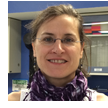| The Great Diseases: Bringing Cutting-edge Biomedical Science to the High School Classroom |
 We can engage our high school students in science by mirroring their real world experiences in the classroom. A particularly good opportunity is to involve them in learning about the science behind health and disease. High school students value learning about these topics—they understand that they all fall sick and they realize they will need to manage their healthcare as they become adults. They appreciate that in the 21st century managing their health requires them to understand something of the underlying science. But here a problem arises—like their students, few teachers have been exposed to the 21st century science behind health and disease, and few resources exist to translate this critical information for their students. Thus an important teaching and learning opportunity is often lost. Read more. We can engage our high school students in science by mirroring their real world experiences in the classroom. A particularly good opportunity is to involve them in learning about the science behind health and disease. High school students value learning about these topics—they understand that they all fall sick and they realize they will need to manage their healthcare as they become adults. They appreciate that in the 21st century managing their health requires them to understand something of the underlying science. But here a problem arises—like their students, few teachers have been exposed to the 21st century science behind health and disease, and few resources exist to translate this critical information for their students. Thus an important teaching and learning opportunity is often lost. Read more. |
| |
| Why Is Active Learning—Known to Confer Deeper Understanding—Still Such a Hard Sell? |
 The July 15th issue of Nature magazine contained an interesting article, “Why We Are Teaching Science Wrong and How to Make It Right”. As Project Manager of MIT BLOSSOMS, this article was of special interest to me since BLOSSOMS has striven for the past seven years to create STEM lessons that show teachers how to encourage active student learning rather than follow a traditional, passive lecture format. According to the Nature article, “evidence has been accumulating for decades that students who actively engage with course material will end up retaining it for much longer than they would have otherwise, and they will be better able to apply their knowledge broadly”. Given this increasing evidence, along with the strong support of active learning proponents like Nobel Prize winner, Physicist Carl Wieman, why is there still such resistance on the part of teachers to use this pedagogy? Read more. The July 15th issue of Nature magazine contained an interesting article, “Why We Are Teaching Science Wrong and How to Make It Right”. As Project Manager of MIT BLOSSOMS, this article was of special interest to me since BLOSSOMS has striven for the past seven years to create STEM lessons that show teachers how to encourage active student learning rather than follow a traditional, passive lecture format. According to the Nature article, “evidence has been accumulating for decades that students who actively engage with course material will end up retaining it for much longer than they would have otherwise, and they will be better able to apply their knowledge broadly”. Given this increasing evidence, along with the strong support of active learning proponents like Nobel Prize winner, Physicist Carl Wieman, why is there still such resistance on the part of teachers to use this pedagogy? Read more. |
|
 |
| Let’s Embed Decision Analytics into Middle School Mathematics to Make Math More Relevant |
 Middle school mathematics develops and builds skills that provide the foundation for learning algebra. One interrelated set of critical skills involves learning about ratios, proportions, rates and percentages. A standard word problem is as follows: Middle school mathematics develops and builds skills that provide the foundation for learning algebra. One interrelated set of critical skills involves learning about ratios, proportions, rates and percentages. A standard word problem is as follows: |
There are thirty children in a class. The ratio of boys to girls is 3:2. How many boys and girls are there in the class?
|
| This simple example illustrates the lack of relevance that pervades math word problems. Here are some of my concerns. |
- How would someone know the ratio is 3:2 if they had not counted the number of boys and girls in the first place?
- Why is anyone interested in the number of boys and girls in this class? Read more.
|
| |
| Rindge School of Technical Arts Biotechnology Program |
 The Biotechnology Program is part of the Rindge School of Technical Arts (RSTA), the technical arm of Cambridge Rindge & Latin School (CRLS). The RSTA Biotechnology Program is Chapter 74 approved and aligned with the Massachusetts Department of Education Career/Vocational Technical Education Framework for biotechnology. It is a three-year course of study designed for students to develop science literacy and proficiency in a broad range of laboratory skills. Students are introduced to fundamental concepts and techniques of cell and molecular biology, genetic engineering, bioinformatics, protein chemistry, and cell culture. In all three levels, there is an emphasis on soft skills important to job and career success including workplace etiquette, teamwork, integrity, flexibility, communication, and leadership. All biotech courses explore prospective careers and work environments through field trips, guest lectures, and independent research. Sound research and presentation skills are emphasized and practiced throughout. Read more. The Biotechnology Program is part of the Rindge School of Technical Arts (RSTA), the technical arm of Cambridge Rindge & Latin School (CRLS). The RSTA Biotechnology Program is Chapter 74 approved and aligned with the Massachusetts Department of Education Career/Vocational Technical Education Framework for biotechnology. It is a three-year course of study designed for students to develop science literacy and proficiency in a broad range of laboratory skills. Students are introduced to fundamental concepts and techniques of cell and molecular biology, genetic engineering, bioinformatics, protein chemistry, and cell culture. In all three levels, there is an emphasis on soft skills important to job and career success including workplace etiquette, teamwork, integrity, flexibility, communication, and leadership. All biotech courses explore prospective careers and work environments through field trips, guest lectures, and independent research. Sound research and presentation skills are emphasized and practiced throughout. Read more. |
|